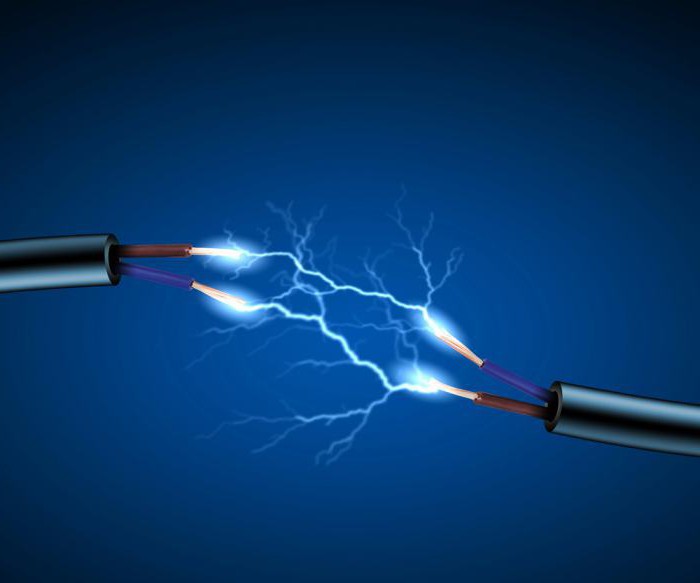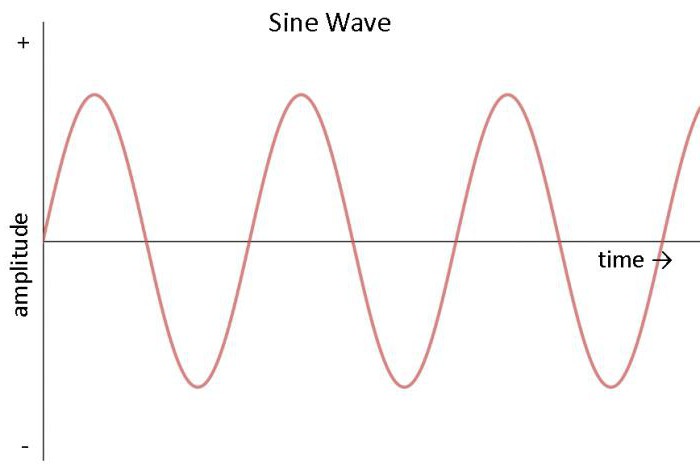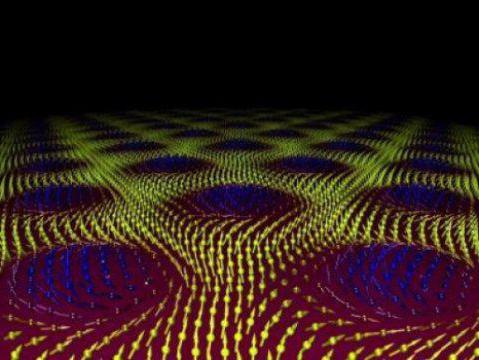Speaking of direct current (see the “About Current” section), we found out that it flows in one direction - from the plus of the source to the minus (this was accepted, although in fact the opposite is true). However, in most cases, you have to deal with alternating current. With an alternating current, the electrons do not move in one direction, but alternately in one or the other, changing their direction. Therefore, when the lighting lamp is turned on, the electrons in its incandescent filament (and in the wires too) move in one direction or the other. This movement is conditionally shown in Fig.1 and Fig.2. Try running one way or the other. It is easy to guess that with such a movement, before changing the direction of movement, you must first slow it down, then freeze in place, and only then rush in the other direction. What is the relationship with current? Before changing the motion, the electrons must slow down (we consider all this in slow time). So the current will decrease, and the lamp should reduce the brightness. And when they stop before changing the movement, it should go out altogether. But we don't see it. Why? Because a hot filament has thermal inertia and cannot cool down in a split second. Therefore, we do not see blinking. However, each of us heard the buzz of a working transformer, which is due to the alternating direction of current movement.
Now it's worth considering. Does this mean that in a fraction of a second, electrons from the power plant reach the house, and in the next fraction of a second - back? Earlier, in the "About current" section, we found out that electric field propagates in conductors at a speed of 300,000 km / s, and the electrons themselves move in conductors at a speed of approximately 0.1 mm / s. But for 1/100 of a second (this is how long one half-cycle lasts, during which the electrons move in one direction), the electrons only have time to move in one direction, as the electric field begins to act in the opposite direction. That is why the electrons are deflected first in one direction, then in the other direction and do not leave, so to speak, the limit of our dwellings. That is, you have your own “home” electrons in your house (apartment). If we could slow down time and plug in a voltmeter in parallel with the load, i.e. lamp (Fig. 3) or an ammeter in series through the load (Fig. 4), then you would see how the arrow of the device smoothly changes its reading from zero to the maximum value when measuring voltage (Fig. 3) or current (Fig. 4). The figure next to it shows this. In reality, of course, we will not see this. The reason is the inertia of the arrow, due to which it cannot produce a hundred per second. By the way, to Fig. 3 and Fig. 4 there is an explanatory Fig. 5, where you can definitely see without much effort how a voltmeter and an ammeter are connected when measuring voltage and current in electrical circuit. Where is the voltmeter and where is the ammeter, I think you can easily guess. In the diagrams, they are designated as V and A, respectively.
So, the first thing you need to know is that changes in current and voltage in an electrical circuit occur according to the so-called sinusoidal law. Second, any sinusoidal oscillation (current or voltage) is characterized by the following important quantities:
Period T is the time it takes to complete one complete oscillation. Half of this time is called a half cycle. Obviously, in one half-cycle, the current flows (well, or, as we stipulated, electrons move) in one direction, which we can conditionally take as positive, and in the other half-cycle it flows in the other direction, which we can take as negative. On the charts, a positive half-cycle will be represented by the upper half-wave above the X-axis, and a negative one by the lower one. Speaking about our network, we can indicate that the period of the alternating current is T \u003d 1 / 50 sec - 0.02 sec.
Frequency f is the number of oscillations per second. Now let's count. If we have one oscillation during the period T, which is equal to 0.02 seconds, then in one second we will have 50 oscillations (1 / 0.02 = 50). And one oscillation is the movement of electrons, first in one direction, then in the other (two half-cycles). Those. for 1 second, the electrons will move alternately in one direction or the other 50 times. Here you have our current frequency in the network, which is 50Hz (Hertz).
Amplitude- the largest value of current (Imax) or voltage (Umax \u003d 310V) during the period T. It is obvious that in one period the sinusoidal current and voltage reach twice their maximum value.
Instant value - we already know that alternating current continuously changes its direction and magnitude. The current voltage is called instantaneous value voltage. The same applies to the magnitude of the current.
As an illustration, Fig. 6 shows several instantaneous values (200V, 300V, 310V, - 150V, - 310V, - 100V) of the voltage in the electrical circuit during one period. It can be seen that at the initial moment the voltage is equal to zero, after which it gradually increases to 100V, 200V, etc. Having reached the maximum value of 310V, the voltage begins to gradually decrease to zero, after which it changes its direction and increases again, reaching a value of minus 310V (- 310V), etc. If someone can hardly imagine what a change of direction is, he can imagine that the plus and minus in the socket are reversed - i.e. if we conditionally take zero (ground) as a minus, and the phase as a plus. And it happens 50 times a second. Well, it's kind of like this...
effective value
So, let's ask ourselves a question - what kind of constant voltage is our AC voltage in the network shown in Figure 6? Theory and practice show that it is equal to a constant voltage of 220V - fig.7. It is not so difficult to take this on faith, since it is easy to see that the voltage considered during one period has a value of 310V only at two moments, and at other times it is less. Since our sinusoidal voltage changes continuously, it was advisable to introduce such a concept as -operating voltage . After all, it is precisely by any specific value of voltage (or current), and not by its changing value, that we can “estimate” its strength. So here it is by the effective value of the alternating current (well, or voltage), we mean such D.C., which in the same time does the same work (or releases the same amount of heat) as a given alternating current.
Therefore, our ordinary light bulb (or, for example, a heating device) will work equally both with an alternating voltage varying from zero to 310V, and with a constant voltage of 220V. And a 12-volt light bulb will shine equally from a source of alternating voltage of 12V (changing from zero to 16.8V), and from any battery or accumulator (and they are, as you know, sources of constant voltage).
So remember!!!
Electric current (voltage), which periodically changes its direction and magnitude, is called alternating current. Any alternating current is characterized mainly by its frequency, amplitude and effective value;
Instruments designed to measure alternating current show its effective value;
Voltage is measured with a voltmeter (or combined instrument - avometer), current - with an ammeter (or combined instrument - avometer). Also, current can be measured with so-called current clamps.. They serve for non-contact measurement of current - the working part of the device forms a ring around the measured wire and, according to the magnitude of the electromagnetic field acting on the working part of the device, information is displayed on its small display about the magnitude of the flowing current. An avometer is a combined instrument (in the common people it is also called simply a tester), which is completely called an ampervoltmeter in its data sheet and serves to measure current, voltage, and resistance. And digital models can measure both the frequency of voltage (current), and the capacitance of capacitors and other things - this is how the developer thinks;
Knowing the value of the (effective) alternating voltage, you can always find out its maximum value (do not forget - it changes according to a sinusoidal law). And the connection here isUmax = 1.4U, where U is the effective value, and Umax is the maximum value (amplitude).
A constant electric current is the movement of particles with a charge in a certain direction. That is, its voltage or force (characterizing quantities) have the same value and direction. This is how direct current differs from alternating current. But let's consider everything in order.
The history of the emergence and "war of currents"
Direct current used to be called galvanic because it was discovered as a result of a galvanic reaction. I tried to transmit it through electric transmission lines. At that time, there were serious disputes between scientists on this issue. They even got the name "current wars". The question of choosing as the main, variable or permanent was decided. The “fight” was won by the variable species, since the permanent one suffers significant losses, transmitted at a distance. But it is not difficult to transform the variable form, this is how direct current differs from alternating current. Therefore, the latter is easy to transmit even over long distances.

Sources of direct electric current
Batteries or other devices can serve as sources, where it occurs through a chemical reaction.
These are generators, where it is obtained as a result and after that it is rectified due to the collector.
Application
In various devices, direct current is used quite often. For example, many household appliances, chargers and car generators work with it. Any portable device is powered by a source that generates a constant look.
On an industrial scale, it is used in engines and batteries. And in some countries they equip high voltage lines power lines.
In medicine, with constant electric current conduct wellness procedures.
On the railway(for transport) both variable and constant types are used.
Alternating current
Most often, however, they use it. Here, the average value of force and stress over a certain period are equal to zero. In magnitude and direction, it is constantly changing, and at regular intervals.

To cause an alternating current, generators are used in which during electromagnetic induction occurs. This is done using a magnet rotated in a cylinder (rotor) and a stator made in the form of a fixed core with a winding.
Alternating current is used in radio, television, telephony and many other systems due to the fact that its voltage and strength can be converted without losing energy almost.
It is widely used in industry, as well as for lighting purposes.
It can be single-phase and multi-phase.
Which changes according to the sinusoidal law, is single-phase. It changes over a certain period of time (period) in magnitude and direction. AC frequency is the number of cycles per second.

In the second case, the three-phase version was most widely used. This is a system of three electrical circuits that have the same frequency and EMF, shifted in phase by 120 degrees. It is used to power electric motors, furnaces, lighting fixtures.
Many developments in the field of electricity and their practical application, as well as the impact on alternating current high frequency Humanity is indebted to the great scientist Nikola Tesla. Until now, not all of his works, which have remained to posterity, are known.
How does direct current differ from alternating current and what is its path from source to consumer?
So, a variable is a current that can change in direction and magnitude for a certain time. The parameters to which attention is paid are the frequency and voltage. In Russia in household electrical networks an alternating current is supplied, having a voltage of 220 V and a frequency of 50 Hz. The frequency of an alternating current is the number of changes in the direction of particles of a certain charge per second. It turns out that at 50 Hz it changes its direction fifty times, in which direct current differs from alternating current.
Its source is sockets to which household appliances are connected under various voltages.
Alternating current begins its movement from power stations, where there are powerful generators, from where it comes out with a voltage of 220 to 330 kV. Further passes into which are located near houses, businesses and other structures.
In the substation, the current enters under a voltage of 10 kV. There it is converted into a three-phase voltage of 380 V. Sometimes with this indicator, the current passes directly to objects (where powerful production is organized). But basically it is reduced to the usual 220 V in all houses.

transformation
It is clear that in the outlets we get alternating current. But often for electrical appliances a permanent look is required. For this purpose, special rectifiers are used. The process consists of the following steps:
- connecting a bridge with four diodes having the necessary power;
- connecting a filter or capacitor to the output from the bridge;
- connection of voltage stabilizers to reduce ripples.
The conversion can take place both from AC to DC, and vice versa. But the latter case will be much more difficult to implement. You will need inverters, which, among other things, are quite expensive.
There are two main types of current - direct and alternating. To understand these terms, it is necessary to remember that current is an ordered movement of electrons. And when these electrons move in the same direction all the time, then such a current is called constant. But the concept of ordered motion should also be understood as the fact that at one moment the electrons move in one direction and at the second moment - in the opposite direction, and so on without stopping. This current is already called variable. If we talk about direct and alternating voltage, then we mean that the constant voltage + and - always “are in the same place”.
An example constant voltage an ordinary battery can serve, on its case you will always find the designations + and -. And for a variable, + and - change after a certain period of time. Consequently constant pressure creates a direct current, and correspondingly alternating voltage - alternating current. An example of an alternating voltage is an ordinary electrical network. Direct current is indicated by one straight line, and alternating current by one wavy line.
I think you have seen the inscriptions 220V more than once, in front of which there is a horizontal wavy line. This is the designation of alternating current.
Please note that the overwhelming majority of devices that use direct current do not allow the + and - contacts to get mixed up when they are connected to power, because if they are mixed up, the device can simply “burn out”. But for alternating voltage, this is no longer relevant, let's say you plug it into an outlet ... yes, whatever, and it doesn’t matter which side you insert the plug into the outlet, the device will work smoothly. Surely, you also had to notice an inscription similar to 50Hz near the 220V inscriptions. This is the AC frequency. And it means how many times per second the “plus and minus” changes places. The inscription 50Hz (Hertz) means that in one second the polarity of the voltage changes 50 times.
Graphs
In order to imagine exactly how the change in the polarity of the alternating voltage occurs, it is necessary to understand the graphs that show the voltage at different points in time. Let's look at a graph showing a constant voltage (it's on the left). Let's assume that this graph shows the voltage at the contacts of a flashlight bulb.
From point 0 to point "a" the graph shows that the voltage is zero. Or in other words, saying it is not there at all (the flashlight is off). At the moment of time "a" (in our version, on the contacts of the light bulb), a voltage equal to U1 appears, which remains unchanged during the time from "a" to "b" (the flashlight is on). At time “b”, the voltage disappears again (becomes equal to zero). If you look at the second graph, which displays the alternating voltage, then I think it's easy to figure out what exactly happens to the alternating voltage at different points in time. At the zero point it is equal to zero. During the time from "0" to "a", the voltage gradually increases to the value of U1 and at the same moment begins to fall. As a result, at time "b" reaches zero. But as you can see in the graph, the voltage continues to fall and becomes negative. At the point "g" reaches a minimum, and again begins to increase. This phenomenon is repeated throughout the existence of the voltage (until the light is turned off. It should be noted that the alternating voltage can be not only of this shape. It can be, for example, rectangular or almost any other shape. Now take another look at these two graphs, and remember , as denoted by direct and alternating current (voltage).





